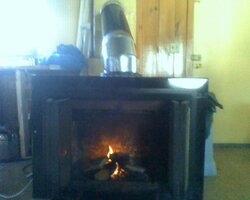I just bought an old Montgomery Ward freestanding wood burning stove. I am using this to heat a small workshop. It puts out good heat but every time I open the gates to add wood the room fills with smoke. I've spent a significant amount of time searching through other forums on this page, got a lot of ideas, but decided to post a direct question. Attached is a picture after install. Based on other forums my ideas are:
1. I am using freshly split wood, which I understand causes more smoke, but shouldn't the smoke still rise out the chimney?
2. May not be getting proper ventillation to force smoke upwards - I have tried opening the stove both with the outside door open and closed, same result.
3. Brick chimney has no liner, this is the first time I have used it, but previous tenants had a stove inplace.
4. Not certain about chimney length requirements - this one has about 8 feet of chimney above where the flue enters. It is a squared chimney 8 inches across.
5. So far I have still been tweeking my method of opening the gates/intake.
6. I purchased some creosote remover but haven't used it yet.
FYI I have checked the chimney - no obstructions. I installed a chimney cap, which has approx. a 3 inch clearance. There is a damper, which is open during burning. This building has a flat roof, chimney extends 2 feet above it.
Any ideas or suggestions would be greatly appreciated!
1. I am using freshly split wood, which I understand causes more smoke, but shouldn't the smoke still rise out the chimney?
2. May not be getting proper ventillation to force smoke upwards - I have tried opening the stove both with the outside door open and closed, same result.
3. Brick chimney has no liner, this is the first time I have used it, but previous tenants had a stove inplace.
4. Not certain about chimney length requirements - this one has about 8 feet of chimney above where the flue enters. It is a squared chimney 8 inches across.
5. So far I have still been tweeking my method of opening the gates/intake.
6. I purchased some creosote remover but haven't used it yet.
FYI I have checked the chimney - no obstructions. I installed a chimney cap, which has approx. a 3 inch clearance. There is a damper, which is open during burning. This building has a flat roof, chimney extends 2 feet above it.
Any ideas or suggestions would be greatly appreciated!


